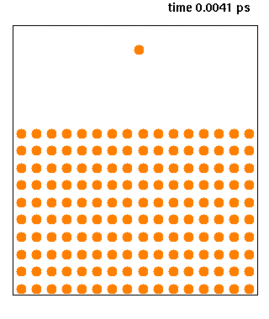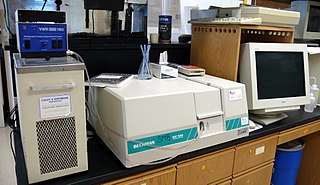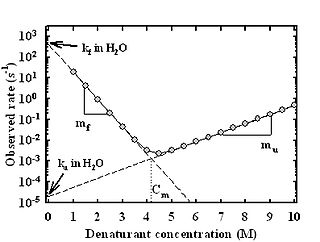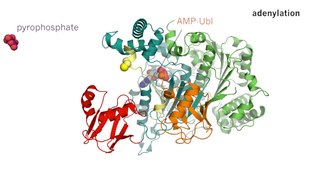Pressure jump is a technique used in the study of chemical kinetics. It involves making rapid changes to the pressure of an experimental system and observing the return to equilibrium or steady state. This allows the study of the shift in equilibrium of reactions that equilibrate in periods between milliseconds to hours (or longer), [1] these changes often being observed using absorption spectroscopy, or fluorescence spectroscopy though other spectroscopic techniques such as CD, [2] FTIR [3] or NMR [4] can also be used.
Chemical kinetics, also known as reaction kinetics, is the study of rates of chemical processes. Chemical kinetics includes investigations of how different experimental conditions can influence the speed of a chemical reaction and yield information about the reaction's mechanism and transition states, as well as the construction of mathematical models that can describe the characteristics of a chemical reaction.
In a chemical reaction, chemical equilibrium is the state in which both reactants and products are present in concentrations which have no further tendency to change with time, so that there is no observable change in the properties of the system. Usually, this state results when the forward reaction proceeds at the same rate as the reverse reaction. The reaction rates of the forward and backward reactions are generally not zero, but equal. Thus, there are no net changes in the concentrations of the reactant(s) and product(s). Such a state is known as dynamic equilibrium.
In chemistry, a steady state is a situation in which all state variables are constant in spite of ongoing processes that strive to change them. For an entire system to be at steady state, i.e. for all state variables of a system to be constant, there must be a flow through the system. A simple example of such a system is the case of a bathtub with the tap running but with the drain unplugged: after a certain time, the water flows in and out at the same rate, so the water level stabilizes and the system is in a steady state.
Historically, pressure jumps were limited to one direction. Most commonly fast drops in pressure were achieved by using a quick release valve or a fast burst membrane. [5] Modern equipment can achieve pressure changes in both directions using either double reservoir arrangements [6] (good for large changes in pressure) or pistons operated by piezoelectric actuators [7] (often faster than valve based approaches). Ultra fast pressure drops can be achieved using electrically disintegrated burst membranes. [8] The ability to automatically repeat measurements and average the results is useful since the reaction amplitudes are often small.
The fractional extent of the reaction (i.e. the percentage change in concentration of a measurable species) depends on the molar volume change (ΔV°) between the reactants and products and the equilibrium position. If K is the equilibrium constant and P is the pressure then the volume change is given by:
where R is the universal gas constant and T is the absolute temperature. The volume change can thus be understood to be the pressure dependency of the change in Gibbs free energy associated with the reaction.
The gas constant is also known as the molar, universal, or ideal gas constant, denoted by the symbol R or R and is equivalent to the Boltzmann constant, but expressed in units of energy per temperature increment per mole, i.e. the pressure–volume product, rather than energy per temperature increment per particle. The constant is also a combination of the constants from Boyle's law, Charles's law, Avogadro's law, and Gay-Lussac's law. It is a physical constant that is featured in many fundamental equations in the physical sciences, such as the ideal gas law and the Nernst equation.

Thermodynamic temperature is the absolute measure of temperature and is one of the principal parameters of thermodynamics.

In thermodynamics, the Gibbs free energy is a thermodynamic potential that can be used to calculate the maximum of reversible work that may be performed by a thermodynamic system at a constant temperature and pressure. The Gibbs free energy is the maximum amount of non-expansion work that can be extracted from a thermodynamically closed system ; this maximum can be attained only in a completely reversible process. When a system transforms reversibly from an initial state to a final state, the decrease in Gibbs free energy equals the work done by the system to its surroundings, minus the work of the pressure forces.
When a single step in a reaction is perturbed in a pressure jump experiment, the reaction follows a single exponential decay function with the reciprocal time constant (1/τ) equal to the sum of the forward and reverse intrinsic rate constants. In more complex reaction networks, when multiple reaction steps are perturbed, then the reciprocal time constants are given by the eigenvalues of the characteristic rate equations. The ability to observe intermediate steps in a reaction pathway is one of the attractive features of this technology. [9]

A quantity is subject to exponential decay if it decreases at a rate proportional to its current value. Symbolically, this process can be expressed by the following differential equation, where N is the quantity and λ (lambda) is a positive rate called the exponential decay constant:
In physics and engineering, the time constant, usually denoted by the Greek letter τ (tau), is the parameter characterizing the response to a step input of a first-order, linear time-invariant (LTI) system. The time constant is the main characteristic unit of a first-order LTI system.




![Host–guest chemistry [[Supramolecular chemistry|Supramolecular structures]] held together other than by covalent bonds](https://upload.wikimedia.org/wikipedia/commons/thumb/9/98/Cucurbit-6-uril_ActaCrystallB-Stru_1984_382.jpg/320px-Cucurbit-6-uril_ActaCrystallB-Stru_1984_382.jpg)





